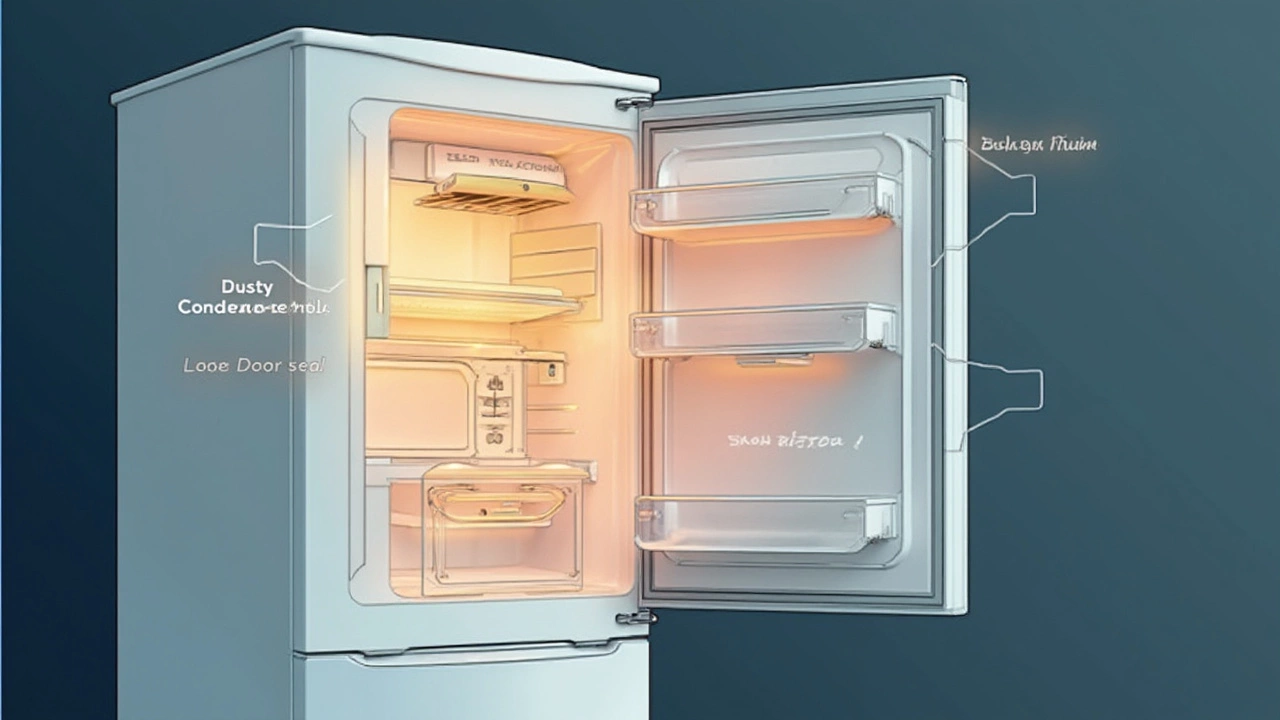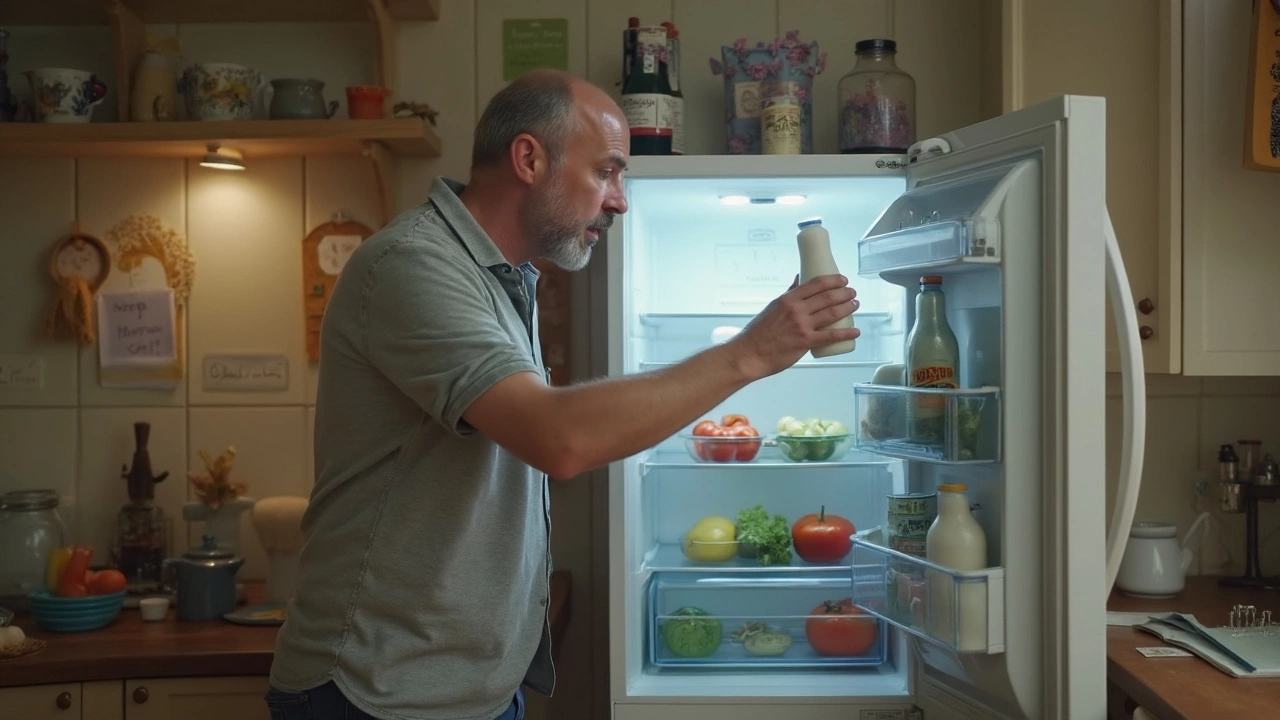A dead fridge is more than a hassle—it’s a potential food waste disaster, especially with a couple of hungry kids ready to raid the kitchen every ten minutes. The weird part? Most fridge breakdowns trace back to just a handful of usual suspects. Before you panic or start online shopping for a replacement, it helps to know what tends to fail first and what you might be able to fix on your own.
Compressor not kicking in? Lights are on but nobody’s cooling? Don’t jump to the worst-case scenario yet. Many times, something simple like a clogged condenser coil, faulty thermostat, or busted door seal is all that’s standing between you and an ice-cold snack. Understanding these common problem areas saves time, money, and weird nights spent Googling 'why does my fridge smell like burnt rubber.'
- Why Fridges Break Down Most Often
- How to Spot a Failing Fridge Component
- DIY Fixes vs. Call-the-Pros Situations
- Keeping Your Fridge Running Smooth
Why Fridges Break Down Most Often
Most folks don’t realize it, but a fridge is one of the hardest working appliances in the house. It’s running 24/7, cycling on and off, trying to keep everything chilled. And with all that work, certain parts just give out more often than others. The main issues usually come from a handful of components that handle the heavy lifting.
Here's what tends to fail the most:
- Compressor: This is basically the heart of your fridge. When it fails, cooling stops. Compressors usually last 8-12 years, but dirty coils, low refrigerant, or power surges can shorten their life.
- Condenser Coils: These get covered in dust and pet hair fast. When that happens, the fridge can't shed heat and ends up working overtime, stressing out other parts too.
- Evaporator Fan Motor: If you hear weird noises or notice poor cooling, this tiny fan could be toast. It's needed to circulate air throughout the fridge.
- Thermostat: When this stops working right, the fridge may run too warm or run non-stop, jacking up your power bill and melting your ice cream.
- Door Gaskets: Cracked or warped seals let cool air slip out. The compressor has to run longer to keep the fridge at the right temp, which just wears stuff out faster.
Check out some numbers from a 2023 repair industry report about fridge repair calls:
| Component | % of Calls |
|---|---|
| Compressor | 25% |
| Condenser coils/fan | 18% |
| Evaporator fan | 15% |
| Thermostat | 14% |
| Door gasket/seal | 10% |
| Other (ice maker, water line, control board, etc.) | 18% |
So, between compressors, coils, fans, thermostats, and those tricky door seals, you’re looking at most of the calls repair folks get. It’s wild how just a dusty coil or loose seal can set off a whole chain of trouble if you don’t catch it early.
How to Spot a Failing Fridge Component
It’s not hard to miss when your fridge is on the fritz—milk goes sour, leftovers sweat, and the inside just isn’t as cold as it used to be. But those are the obvious clues. If you want to catch problems early and avoid tossing out full bags of groceries, keep an eye—and ear—on these details.
- Fridge repair often begins with simple checks like listening for odd noises—clicking, buzzing, or grinding sounds can mean the compressor or fan is struggling.
- If your fridge runs constantly without a break, that’s another red flag. A healthy fridge should click on, chill things down, then rest. If it’s running non-stop, your thermostat, door seal, or temperature sensor might be acting up.
- Water pooling under the fridge or around the vegetable drawers is usually a blocked defrost drain or failing door seal. Ignore it, and you risk water damage to the floor—been there, dealt with it, not fun.
- Lights out in the fridge? Sometimes it’s just a bulb, but if changing it doesn’t help, there’s probably an issue with the light switch or wiring.
- Ice buildup in the freezer section can signal problems with the defrost system, especially if the fridge side starts warming up, too.
You can also sniff out trouble—literally. A chemical or slightly burning smell can point to overheated wiring or a failing compressor. If you catch that, unplug the fridge right away and call a repair tech.
Here’s a quick cheat sheet to match symptoms to likely culprits:
| Symptom | Possible Faulty Part |
|---|---|
| Fridge warm, freezer cold | Defrost system, evaporator fan |
| Fridge runs non-stop | Door seal, thermostat, temperature sensor |
| Strange noise | Compressor, condensor or evaporator fan motor |
| Water in fridge | Defrost drain or door seal |
| No lights | Light bulb, door switch |
Taking a minute to check these things can help you catch a problem early. Sometimes, catching a failing part now means a simple fix—not a total fridge disaster next week.

DIY Fixes vs. Call-the-Pros Situations
Chances are, your fridge repair situation falls into one of two lanes: quick fix at home, or a call to someone with a tool belt and way more experience. Knowing which lane you’re in saves time, frustration, and cash. Here are some situations where you can roll up your sleeves—plus the stuff where it’s safer to let a pro step in.
- Fridge repair starts easy with basics. Is your fridge not cooling but the light works? First, double-check the power. Try plugging another appliance in the same outlet. If it works, move on to cleaning the condenser coils (those dirty wires behind or under the fridge). Grab a vacuum or a coil brush kit. A thick layer of dust is a super common culprit—sometimes it reduces cooling by up to 30%!
- If your door won’t shut tight, inspect the gasket (that rubber seal). Replace it if it’s cracked or won’t cling to the door. You can find DIY gasket kits at most hardware stores. Hot tip: Slip a dollar bill between the door and fridge. If it slides out easily, your seal is shot. Average cost to fix this yourself is around $25.
- Hear clicking or buzzing? The problem might be the start relay—this is what helps the compressor turn on. If you’re handy, swapping this part takes ten minutes and less than $30, but be sure to unplug first.
If your issue is any of the following, it’s time to call in a pro:
- Compressor not running, even after replacing the start relay (this is the heart of your fridge and requires specialty tools).
- Strange burning smell or visible ice build-up inside the freezer (could point to failing defrost heater or electrical problems).
- Fridge is leaking coolant or you see oil under your fridge (dangerous and not for DIY—the refrigerant can be harmful).
- Digital display flashing error codes you can’t find in the manual.
To help you decide, check out this quick breakdown of costs and risks:
| Problem | DIY Cost | Pro Cost | Risk Level |
|---|---|---|---|
| Dirty condenser coils | $0 - $10 | $80 - $150 | Low |
| Door gasket replacement | $25 - $60 | $110 - $250 | Low |
| Start relay swap | $20 - $40 | $100 - $300 | Medium |
| Compressor repair | Don’t DIY | $400 - $700+ | High |
| Coolant leak | Don’t DIY | $200 - $500 | High |
Bottom line: if it’s electrical, involves refrigerant, or you need to tear the fridge apart, let a certified tech handle it. For everything else, a quick YouTube video and an afternoon might save your groceries and your budget.
Keeping Your Fridge Running Smooth
You’d be surprised how long a fridge can last if you give it basic care. The average fridge in the U.S. runs for about 13 years, but some make it to 20 with just a bit of regular attention. The trick? Spot problems before they snowball and stick to a simple maintenance routine.
Here’s what actually works to keep a fridge repair call away:
- Clean the coils: Dirty coils make your fridge work harder and burn out faster. Once every six months, unplug the fridge and vacuum or brush off the coils (usually at the back or bottom).
- Check the door seals: If you can easily slip a dollar bill through the door gasket when it’s closed, cold air is leaking out. Wipe down seals with soapy water and replace them if they’re cracked or loose.
- Keep it stocked... but not packed: A half-full fridge holds temperature better than an empty one, but if you overload it, air can’t circulate and stuff doesn’t chill evenly.
- Set the right temps: Aim for 37-40°F for the fridge and 0°F for the freezer. Use a cheap fridge thermometer to check—don’t trust the dial if food keeps going soft or icy.
- Defrost matters: If you see frost building up in a “frost-free” freezer, it’s not normal. Defrost manually if needed and make sure the defrost drain isn’t plugged.
Quick tip: If you hear weird noises, give a listen. Grinding or clicking often points to fan or compressor issues. Buzzing can just be the ice maker refilling or the compressor running, but don’t ignore sounds you haven’t heard before.
| Maintenance Task | How Often | Why It Matters |
|---|---|---|
| Coil Cleaning | Every 6 months | Prevents overheating, saves energy |
| Seal Check | Every 3 months | Stops cold air leaks, keeps food safe |
| Temperature Check | Monthly | Reduces food spoilage risk |
| Interior Cleaning | Monthly | Keeps smells and mold away |
Want your fridge to keep going strong through every snack raid and leftover night? Give it a few minutes of attention now and then—it’s way cheaper than a new appliance or emergency repair call.

